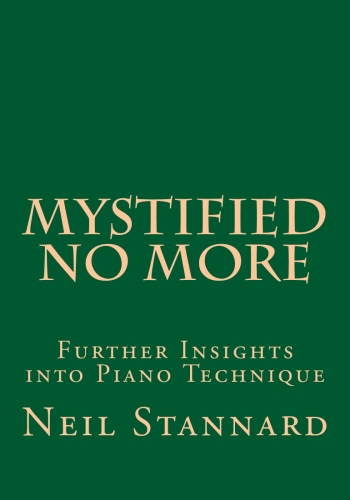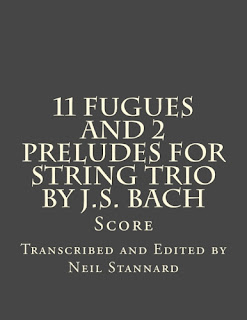Playing the Piano is Easy and Doesn't Hurt! Learn how to solve technical problems in Bach, Mozart, Beethoven, Chopin and all the other composers you want to play. Reconsider whether to spend time on exercises and etudes or music. Discover ways to avoid discomfort and injury and at the same time increase learning efficiency. How are fast octaves managed without strain? How are leaps achieved without seeming to move? And listen to great pianists of the past.
“Music is a moral law. It gives a soul to the universe, wings to the mind, flight to the imagination, a charm to sadness, and life to everything. It is the essence of order, and leads to all that is good, just and beautiful, of which it is the invisible, but nevertheless dazzling, passionate, and eternal form.” Plato
Monday, November 30, 2015
Sunday, November 22, 2015
Dear Readers,
Some of you have asked for the parts to the latest string trios, 11 Fugues and 2 Preludes by J.S Bach. I am happy to report they are now available at Amazon and the "Look Inside" feature should be available in a few days.
Also, I plan to post new blogs soon in answer to piano questions, which, of course is supposed to be our topic.
Also, also, watch for a new book, a sort of sequel to Piano Technique Demystified: Insights into Problem Solving, which will be called Mystified No More: Further Insights into Piano Technique, in which I offer more on developing a practical technique, practicing in general, geography of the keyboard, folks unclear on the concept (Hanon and Czerny), finding and using scales and a wealth of other topics of nagging interest to pianists. I solve the case of the missing thumb, point out where the small notes go and (sigh) once again address the topic that won't die: stretching exercises for pianists. There are at last count 136 musical examples and iDemos too numerous to count. But that's not all...
Thursday, September 17, 2015
More Music for String Trio
 Since many of my readers moon-light as string players, I announce here a new volume of string trios, 11 Fugues and 2 Preludes for String Trio by J.S. Bach.
Since many of my readers moon-light as string players, I announce here a new volume of string trios, 11 Fugues and 2 Preludes for String Trio by J.S. Bach. The two books of 24 preludes and fugues in all major and minor keys have become the touchstone for keyboard players desirous of developing a sense of Baroque style. They were indeed conceived originally for a keyboard tuned with more or less equal intervals, but as always in Bach’s keyboard works, their probative value reaches far beyond the mere pressing down of keys in the proper order.
Bach sought to teach the complete musician in his Clavier Übung, of which the Well-Tempered Clavier is a part. Übung is translated for our purposes not just as practice in the general sense of learning technique. It also means emersion in the essence of the art, as in the practice of medicine or law. These pieces are about learning composition and a cantabile style of playing, and, in short, how to bring music to life.
We know that Bach transcribed not only his own works for
different combinations of instruments, but also the works of other composers. I include here all of the three-part fugues and two preludes from Book I, some of which appear in Bach’s hand in earlier versions and in different keys. This tilted the scales in favor of my offering more amiable transpositions for strings of some of the gnarliest keys. For the intrepid, I have also included those pieces in their original keys. It has been speculated that transcribing works was for Bach a method of study or an effort to make rare compositions more generally available to the public. Possibly. I am more moved, however, by Albert Schweitzer’s assertion that “this was his way and it gave him pleasure.” It is in the latter spirit that I offer here these tasty morsels.
Tuesday, August 25, 2015
The Pianist's Guide to Practical Scales and Arpeggios
 |
| Scales and Arpeggios from the Repertoire |
A student asks about boosting speed in the study of scales and arpeggios as they appear in repertoire, which is the subject of this volume. As always, my advice is to play no slower than needed and not faster than you can. This means that at each tempo, from slow to fast, the technique always feels easy.
This begs the question, how does one achieve ease? Well, the first step is to solve the physical problem(s), decide what is needed for speed and work that in slowly. Yes, this is possible with knowledge of how the playing mechanism works. (See Piano Technique Demystified: Insights into Problem Solving.)
Here are some questions to ask yourself: What fingering will allow me to group notes to keep them under my hand without extreme stretches? How do I use the last note of one group to get to the first note of the next group? Is there a shape to the passage, under or over, in or out? What is the angle of my forearm relative to the keyboard, meaning, if I am approaching a thumb crossing, do I have my thumb behind each finger as it plays on the way to the thumb? Working up to top tempo is an excellent use of the metronome, especially when working in sections. I do not recommend using the metronome for playing through an entire work.
Here are some questions to ask yourself: What fingering will allow me to group notes to keep them under my hand without extreme stretches? How do I use the last note of one group to get to the first note of the next group? Is there a shape to the passage, under or over, in or out? What is the angle of my forearm relative to the keyboard, meaning, if I am approaching a thumb crossing, do I have my thumb behind each finger as it plays on the way to the thumb? Working up to top tempo is an excellent use of the metronome, especially when working in sections. I do not recommend using the metronome for playing through an entire work.
Sunday, August 23, 2015
Chopin Nocturne Op. 62, No. 2: Tension in the Agitato
 |
| Frederic Chopin |
A student writes: "1. Configurations of four sixteenth notes with a syncopated inner voice, such as in the 3rd/4th beat of the 1st measure, or the 2nd beat of the 2nd measure, seem to give me the most trouble. I feel tension immediately, along with a general lack of coordination.
2. The 2nd beat of the 6th measure, with its slightly awkward 1-2-5 (C#-D#-C#) reach, is also uncomfortable."
| Chopin Nocturne Op. 62, No. 2, (Agitato) As Printed |
My response: You are quite right, rotation is involved. But maybe the simplest way to go about solving this is to keep in mind that when playing chords mixed with single notes, the chord feels "down," slightly heavier. In the example below, you'll see that the technique levels the playing field. That is, I think of playing constant sixteenth notes, noticing the rotation and feeling the heavier chord. One way to "feel" the heavier chord is to group from the chord, start from it. I've included my fingering, but other approaches can also work. Be sure to avoid clinging and gripping, as if you were playing the organ. You can use pedal discretely. Once that is worked in, the rest is just a matter of voicing. In other words, show the melodic line. The second part of your question is much simpler. In measure six of the example above, second beat, take the C-sharp and D-sharp with the thumb.
 |
| Chopin Nocturne Op. 62, No. 2, Technique |
Tuesday, July 21, 2015
Speed at the Piano
A student writes: "Is there a most efficient approach to achieving speed? Unevenness in runs and mistakes in tricky passages often seem to result from inhibitory muscle tension (the readiness to stop a motion that is wrong). When playing music I can often *feel* mistakes or complete disasters coming seconds before they occur. This may be a slow tightening of the don’t-do-that muscles."
 |
| Muscle tension |
My answer: Your main question is about achieving speed and accuracy in scales and passages. From what you describe, though, I get the impression—this is impossible to know without watching you play—that you are not at rest at the bottom of the key. That is, you seem to be holding ("inhibitory muscle tension"), instead of releasing. Try this on one note: drop into the key with your finger/hand/forearm
aligned in such a way that it feels like a single unit. You are not pressing down past the key bed and you are not lifting
up. Find out what it takes to stand there; you are not tense, neither are you relaxed. This is akin to standing at ease, as in the army, or sitting upright in a chair. The next step is to find out how to transfer that weight to the next note via forearm rotation. (Have a look at the iDemos.)
 |
| Sitting upright without tension |
 |
| At ease |
If you "cannot play a particular pattern," it means you haven't found the technical solution(s), i.e., grouping, fingering, shaping, etc. I know this sounds like a cop out, but it's really true. There are always answers. When playing a scale, for example, make sure that the thumb is approximately behind the finger playing as you approach the crossing (see iDemo). This puts your forearm at an angle with the keyboard.
Once the technical solutions have been worked-in,
gradually increase the tempo in units. In the case of the scale, include the thumb crossing in a unit. For example, 1,2,3,1,2 and 1,2,3,4,1,2. This is a very good use of the metronome. Play each unit at least three times at each tempo before going on to the next tempo, noting that nothing changes in the ease of playing. This repetition is not for strength training but for teaching the correct movements to the playing apparatus. When each unit feels great at the desired tempo, then try combining two units and working them up together from slower to faster, although you may not need to start sat the slowest tempo.
 |
| Old-fashioned metronome |
Don't try to work up speed until you have decided on and worked-in the technical solutions.
Subscribe to:
Posts (Atom)




